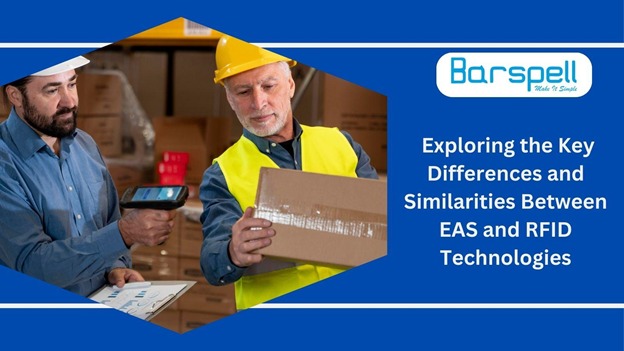Exploring the Key Differences and Similarities Between EAS and RFID Technologies

Exploring the Key Differences and Similarities Between EAS and RFID Technologies
In the world of modern retail and inventory management, technologies like Electronic Article Surveillance (EAS) and RadioFrequency Identification (RFID) play crucial roles. Both are pivotal in enhancing security, optimizing inventory control, and improving the overall shopping experience. However, despite their common objectives, EAS and RFID differ significantly in their mechanisms and applications. In this blog, we'll delve into the distinctive features and surprising parallels between EAS and RFID technologies.
Understanding EAS and RFID:
Electronic Article Surveillance (EAS): EAS is a security system designed to prevent theft in retail stores and libraries. It typically involves attaching special tags or labels to merchandise or library items. These tags contain a marker that triggers an alarm when passing through a detection system installed at the store's exit. The primary function of EAS is to deter theft by alerting store personnel of unauthorized removal of items.
RadioFrequency Identification (RFID): RFID is a versatile technology that uses radio waves to identify and track objects. It consists of tags containing electronically stored information and readers that communicate with these tags wirelessly. RFID tags can be passive, requiring an external RFID reader to provide power and collect data, or active, containing a battery to transmit data independently. RFID systems are widely used in various industries, including retail, logistics, healthcare, and manufacturing, for inventory management, asset tracking, and supply chain optimization.
Key Differences Between EAS and RFID:
1. Purpose:
EAS: Primarily focused on theft prevention and security in retail and library environments.
RFID: Used for a broader range of applications, including inventory management, asset tracking, and supply chain optimization.
2. Technology:
EAS: Relies on a simple electromagnetic or acoustomagnetic system to detect tagged items passing through a detection zone.
RFID: Utilizes radio frequency communication between RFID tags and readers to identify and track objects in real time.
3. Tag Types:
EAS: EAS Tags are typically passive and do not store unique identification information. They are designed to trigger an alarm when passing through a detection system.
RFID: RFID Tags can be passive or active and contain unique identification data, allowing for precise tracking and management of individual items
4. Range and Readability:
EAS: Detection range is limited to the vicinity of the detection system, usually within a few feet.
RFID: Depending on the type of RFID system and tags used, read range can vary from a few inches to several meters, enabling long range tracking and monitoring.
5. Cost:
EAS: Generally considered more cost effective for basic theft prevention purposes due to simpler technology and lower implementation costs.
RFID: Initial setup costs may be higher due to the need for RFID readers and specialized tags, but the technology offers greater functionality and potential cost savings in the long run through improved efficiency and inventory accuracy.
Similarities Between EAS and RFID:
1. Security Enhancement: Both EAS and RFID contribute to enhancing security in retail environments, albeit through different mechanisms. While EAS focuses on deterring theft through alarm activation, RFID enables real time tracking and monitoring of merchandise, reducing the risk of loss or pilferage.
2. Retail Integration: Despite serving different primary purposes, both EAS and RFID technologies are seamlessly integrated into retail operations to improve inventory management and customer service. Retailers often deploy these technologies in combination to achieve comprehensive security and tracking solutions.
3. Customer Experience: Both EAS and RFID technologies aim to enhance the overall shopping experience by ensuring product availability, minimizing stockouts, and streamlining checkout processes. By optimizing inventory accuracy and reducing shrinkage, retailers can provide customers with a more satisfying shopping experience.
While Electronic Article Surveillance (EAS) and RadioFrequency Identification (RFID) technologies differ in their mechanisms and primary applications, they share common goals of enhancing security, improving efficiency, and enhancing the overall customer experience in retail environments. By understanding the distinctive features and surprising parallels between EAS and RFID, retailers can leverage these technologies effectively to mitigate theft, streamline operations, and stay competitive in today's dynamic market landscape.
Barspell Technologies India Private Limited is a market leader in EAS and RFID technology in Pune & across India. We'll be happy to discuss your specific needs and provide you with a customized solution.
Call us at 9371-804-300 / 301 / 302 or visit our website at https://barspell.com/ in to learn more.
We look forward to partnering with you to achieve your business goals !


